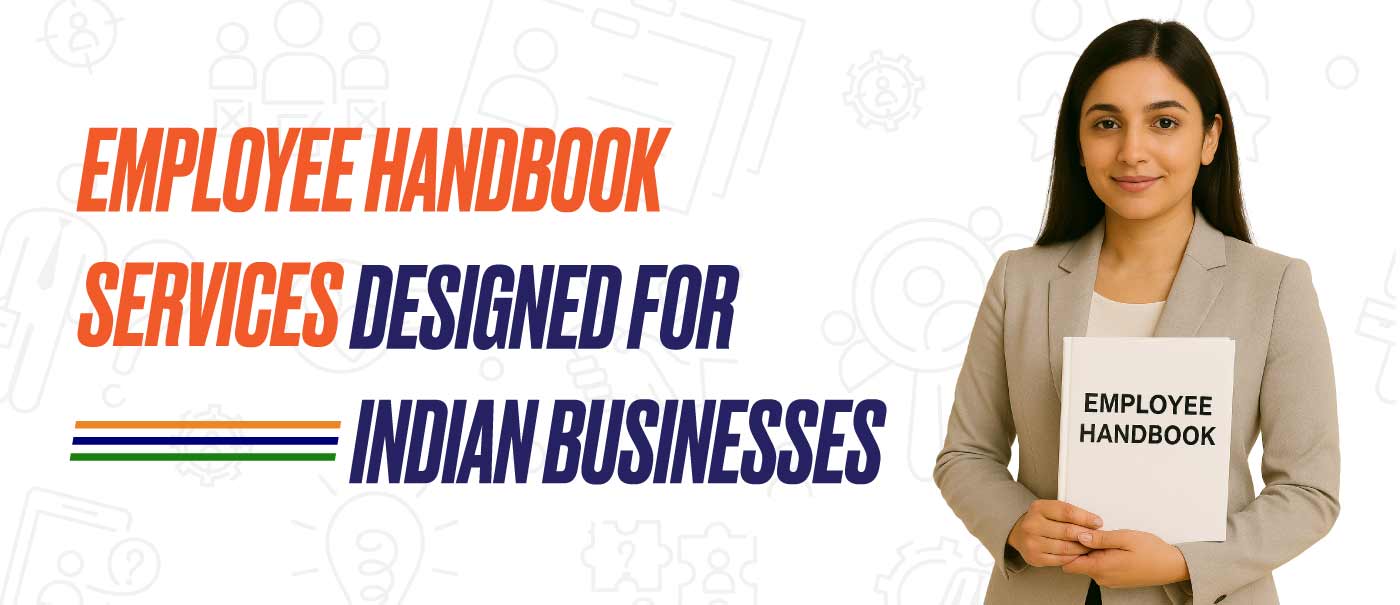Get Employee
Handbook
Expert-drafted HR handbook as per Indian laws at just INR 19999/- only.
Trusted by 5000+ businesses across India. Draft yours today.

Customized | Employee-Friendly
Expert-drafted HR handbook as per Indian laws at just INR 19999/- only.
Trusted by 5000+ businesses across India. Draft yours today.

Customized | Employee-Friendly
An Employee Handbook is a central guide that explains how a company works and what employees can expect at the workplace. It is also known as a Staff Handbook, HR Handbook, HR Manual, or Employee Manual. This document sets out the company’s rules, values, and policies in a simple and organized way so that employees know their rights and responsibilities clearly.
A Sample Employee Handbook for Indian companies usually covers areas such as working hours, leave and holidays, statutory benefits like PF, ESI, and gratuity, rules on professional conduct, workplace safety, and procedures for grievance redressal or disciplinary actions. It also includes mandatory compliance requirements like the POSH policy.
 For founders and business owners, an Employee Handbook is more than just paperwork. It creates transparency, builds trust, and ensures that everyone in the organization follows the same set of rules. By putting company policies in writing, you reduce confusion, avoid disputes, and make sure your business stays compliant with Indian labor laws.
For founders and business owners, an Employee Handbook is more than just paperwork. It creates transparency, builds trust, and ensures that everyone in the organization follows the same set of rules. By putting company policies in writing, you reduce confusion, avoid disputes, and make sure your business stays compliant with Indian labor laws.
Please visit below blog to get detailed information about our 25+ Templates and how it works
At Ebizfiling, we don’t just create a generic policy document; we prepare a customized Employee Handbook that is legally compliant, easy to understand, and aligned with your company’s culture. Our team of experts combines HR knowledge with compliance expertise, ensuring your handbook covers every essential policy, from working hours and leave to statutory benefits and POSH. With experience serving 5000+ businesses across India, we deliver handbooks that protect your company, support your employees, and grow with your business.
(All Inclusive)
(All Inclusive)
(All Inclusive)
A single HR Manual avoids different interpretations of rules and ensures all employees are treated fairly with the same set of standards.
An Employee Handbook acts as a ready guide for employees, helping them understand company rules, benefits, and responsibilities without confusion.
By including statutory policies such as leave entitlements, PF, ESI, gratuity, and the POSH policy, the handbook ensures your company stays aligned with Indian labor laws.
New hires can quickly learn about working hours, leave rules, and code of conduct through a Sample Employee Handbook, making the onboarding process faster and more professional.
When employees know their rights, benefits, and grievance redress process, they feel more secure and confident in the workplace.
An Employee Handbook also communicates company values, ethics, and workplace expectations, helping employees connect with the organizational culture.
Since company policies are documented, misunderstandings between management and staff are minimized, reducing the chances of disputes.
A properly written Employee Manual protects employers by documenting policies on termination, disciplinary action, and workplace behavior in a legally compliant way.
An Employee Handbook brings together all the key workplace policies and practices that employees need to know. It acts as both a guide for staff and a compliance tool for employers. A well-drafted handbook for Indian companies usually includes:
1. Company Introduction and Values: A welcome note, company mission, vision, and culture statement so that employees understand the bigger picture of the organization.
2. Employment Classifications: Clear definitions of full-time, part-time, temporary, contractual, probationary staff, and interns, along with the benefits and rules applicable to each group.
3. Code of Conduct: Workplace behavior guidelines covering professionalism, ethics, integrity, dress code (if applicable), punctuality, confidentiality, use of social media, and anti-discrimination policies.
4. Working Hours, Leave, and Holidays: Details on office timings, work schedules, overtime policies, weekly offs, national and festival holidays, and leave entitlements such as casual leave, sick leave, earned leave, and maternity leave.
5. Statutory Benefits: Explanation of legally mandated benefits including Provident Fund (PF), Employee State Insurance (ESI), gratuity, bonus, and other welfare benefits, so employees know what they are entitled to.
6. Compensation and Salary Structure: Information on how salaries are structured, pay dates, statutory deductions (TDS, PF, ESI), and reimbursement policies.
7. POSH Policy: The Prevention of Sexual Harassment (POSH) policy as per Indian law, including a zero-tolerance statement, what constitutes harassment, how complaints can be filed, and the role of the Internal Complaints Committee.
8. Health, Safety, and Welfare: Guidelines on workplace safety, emergency procedures, medical assistance, and employee welfare practices.
9. Remote Work and IT Usage: Policies for work-from-home or hybrid models, rules on internet and email usage, data privacy, cybersecurity, and safeguarding company property like laptops or access cards.
10. Performance Management and Training: The process of appraisals, promotions, learning and development opportunities, and employee growth policies (optional but often included).
11. Disciplinary Procedures and Termination: Steps for dealing with misconduct, warnings, suspensions, and termination. Also covers notice periods, exit formalities, full and final settlement, and return of company assets.
12. Grievance Redressal Mechanism: A clear process for employees to raise complaints or issues (other than POSH), along with the roles of HR or a grievance officer in resolving them fairly.
13. Employment Letters and Agreements (Attached or Referenced): While not always included inside the handbook, companies often issue standard documents like Offer Letters, Appointment Letters, Employment Contracts, and NDAs in line with the policies mentioned in the handbook.
14. Acknowledgment Section: A declaration page that employees sign to confirm they have read and understood the handbook, which protects the employer in case of disputes.
Some organizations also include policies on travel and expense reimbursement, employee referral programs, social media guidelines, and workplace etiquette depending on their industry.
In short, an HR policy manual or Staff Handbook acts as a complete manual that covers everything from joining to exit, ensuring transparency, compliance, and smooth management of employees.
Maintain Books & Accounts
Custom Drafting
Employment Documents
Compliance Check
Finalization and Delivery
Information on office timings, shift schedules, weekly offs, types of leave, and the company’s holiday calendar.
Any old Staff Handbook, HR Policies, Appointment Letters, Employment Contracts, or Offer Letters (if available) to review and align with the new handbook.
Basic details such as industry, number of employees, locations, and organizational structure.
Details of statutory and additional benefits offered (PF, ESI, gratuity, insurance, bonus, reimbursements).
Mission, vision, values, and workplace culture that should be reflected in the handbook.
HR representatives or leadership members who will review drafts and provide feedback.
State-specific labor law requirements and details of mandatory committees such as the Internal Complaints Committee under the POSH Act.
Any unique rules such as dress code, remote work guidelines, IT usage, travel policy, or expense reimbursements.

No, an Employee Handbook is not legally mandatory in India, but it is considered a best practice as it helps maintain compliance, transparency, and consistency across the organization.
The main purpose of an Employee Handbook is to communicate workplace rules clearly, employee rights, company policies, and compliance requirements, ensuring both employees and employers are aligned.
An Employee Handbook is usually prepared by the HR team in consultation with management, but many businesses choose professional consultants like Ebizfiling to ensure legal accuracy and customization.
An Employee Handbook typically includes company introduction, employment classifications, code of conduct, working hours, leave and holidays, statutory benefits, POSH policy, disciplinary and termination rules, grievance redressal, and IT or remote work policies.
An Employee Handbook helps new employees quickly understand company culture, workplace expectations, leave rules, benefits, and grievance procedures, making the onboarding process smooth and clear.
No, an Employee Handbook cannot replace an Employment Agreement. While the handbook explains policies, each employee still needs a legally valid Offer Letter, Appointment Letter, or Employment Contract.
Yes, companies with 10 or more employees are legally required to include a Prevention of Sexual Harassment (POSH) policy in their Employee Handbook, along with details of the Internal Complaints Committee.
An Employee Handbook should be reviewed and updated at least once a year or whenever there are changes in company policies or labor laws, to ensure it remains accurate and compliant.
If a company does not have an Employee Handbook, employees may lack clarity on policies, disputes may increase, and the company may face compliance risks in areas such as leave, benefits, or workplace harassment.
All employees of the company, including full-time staff, part-time staff, probationary employees, interns, and contract workers, need to follow the policies mentioned in the Employee Handbook.
Yes, even small businesses can benefit from having an Employee Handbook as it helps set clear expectations from the beginning and avoids misunderstandings as the company grows.
On average, it takes between two to four weeks to prepare an Employee Handbook, depending on company size, the number of policies required, and the speed of inputs from the management team.
An Employee Handbook in India should comply with the Shops and Establishments Act (state-specific), Maternity Benefit Act, POSH Act, Payment of Gratuity Act, Employees’ Provident Fund Act, Employees’ State Insurance Act, and the new Labor Codes.
An Employee Handbook is generally not considered a legally binding contract, but it serves as strong evidence of company policies and can protect the employer in case of disputes if employees have signed acknowledgment.
Employees usually acknowledge the Employee Handbook by signing a declaration form or acknowledgment page confirming that they have read and understood the policies.
Yes, an Employee Handbook can and should include company-specific policies such as dress codes, remote work rules, IT usage guidelines, travel reimbursements, or any unique internal practices.
An Employee Handbook is written for employees and explains rules and benefits in simple language, while a Policy Manual is usually more detailed and technical, often meant for HR or management use.
Yes, some sections of the Employee Handbook may vary by state, especially working hours, leave entitlements, and holidays, as these are governed by state-specific Shops and Establishments Acts.
Yes, companies can issue an Employee Handbook in digital format, such as PDF or intranet access, as long as employees receive it and provide acknowledgment of having read it.
Companies should use professionals to prepare an Employee Handbook because it ensures the content is legally compliant, customized to the business, employee-friendly, and aligned with current Indian labor regulations.
Expert-drafted HR handbook as per Indian laws at just INR 19999/- only.
Trusted by 5000+ businesses across India. Draft yours today.
Ebizfiling's customer dealing service is International level. Good.
Easy and Fast Thanks for the Help, Very Nice Services will contact for other services too.
